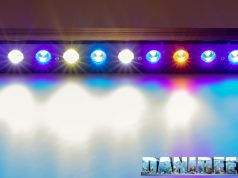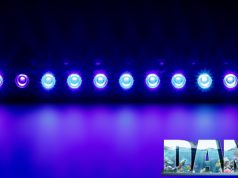
Finally we tried the GNC BluRay PRO, ceiling lights we always heard good things about, that we tested thoroughly in an unusual DaniReef LAB when we visited our friend Luca Perini on occasion of the reportage on his beautiful marine aquarium.
This article is also available in: Italiano
So, the DaniReef LAB was a bit unusual. We packed all the tools and brought them at Luca’s. We thought that there we could have set our base with the references over Luca’s tank and hang the ceiling lights at the right distances… But we faced the reality, because the cables were too short and the ceiling light didn’t want to stay balanced on the aluminium spacers. So we removed the ceiling light and placed it on the ground, where it was easier for the measurements. Sure, we weren’t at home and we left something compared to our other tests, but the result now it’s comparable with the other ceiling lights we tested until today.
We tried the GNC 466 back in 2013 and we were extremely satisfied, even though at time the price was incredibly high. If you want, here “LED fixture Sicce GNC AM 466 In depth review” you can read what we reported.
The philosophy behind the ceiling light didn’t change much since then. It has many, many low-powered LED, 588, and a great heat sink: a lot of diffused light with a beautifully low power consumption. And, unlike then, today there’s the possibility to dim the three LED channels.
We were very curious to test it our DaniReef LAB, so we just have to leave you to the article to see how it went!
Technical characteristics of the GNC BluRay PRO
The ciling light is rectangular, only 4 cm of height and 30×40 cm of base. The LED of GNC BluRay PRO are of 5 different typologies, grouped in 3 channels. There aren’t LED dedicated to the moonlight.
| Characteristics | GNC BluRay Pro | GNC Bluray |
| Sizes | 300x400x40 mm | 300x400x40 mm |
| Aquarium coverage | 90×70 cm | 90×70 cm |
| White 12.000°K LED | 264 | 336 |
| Royal Blue 460 nm LED | 268 | |
| Royal Blue 450 nm LED | 24 | 196 |
| Deep Red 660 nm LED | 16 | 56 |
| UV 405 nm LED | 16 | |
| Total LED | 588 | 588 |
| Total maximum consumption | 130 watt | 130 watt |

Compared with the previous BluRay, the number of LED is still 588, so given the consumption of 130 watt it has 0,25 watt of consumption per LED. This low-power piloting benefits the LED and their durability.
The spectrum is declared complete, but compared to the usual BluRay the blue 450 nm LED have been removed to insert the Royal Blue LED of 460 nm. The number of white LED is lower and finally there are the UV LED, even if in a rather limited number. Even the red LED are sharply decreased. So the spectrum should result more blue and with more fluorescences then the classic BluRay. After the experience on the field where several aquarists low the reds and add blue bars, I’d say that the LEDs chosen are particularly right.
Luca Perini’s aquarium in action in our video
At 12:40 you can see the PAR measurement in aquarium. And we’ll return on this point in our final considerations. Now enjoy the video! It’s in Italian, but you can turn the English subs on.
Construction
The ceiling light, as GNC has accustomed us, is very well built and incredibly solid. The GNC BluRay PRO is the result of three souls fused together. On the top there’s the very generous aluminum heat sink connected to the LED Core, the second layer of the ceiling light, and then there’s the acrylic sheet that protects the LED from the splashes and helps keeping them cooled.

The programming
The programming of the ceiling light is done via wi-fi, without a dedicated app, but using a web browser.
Every ceiling light has a on-board wifi module, which one must necessarily connect to, and via browser you can set the main parameters of the ceiling light. You can set the dimming of the available channels and the dimming of dawn and sunset. With the PRO you can also add the cloud or storm effect, and the useful demo mode, that allows to to see the photoperiod condensed in a few minutes, both for impress our friends and evaluate its real functioning. At first sight it might seem a stupid function, but I think it’s more useful that it seems.

All the values we measured and our working method called DaniReef LAB are on page two.












